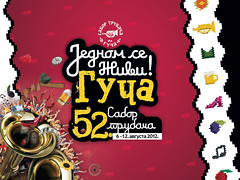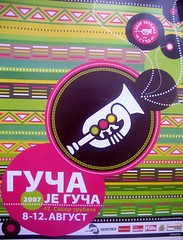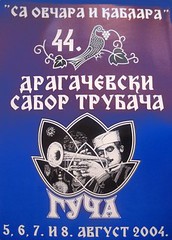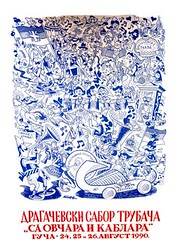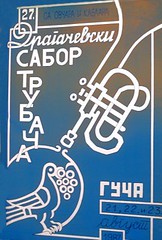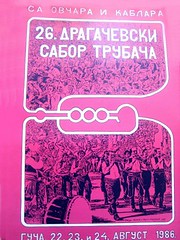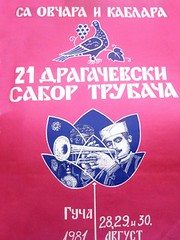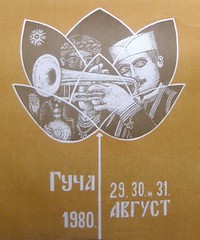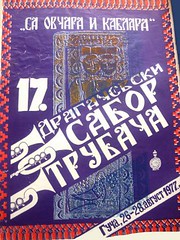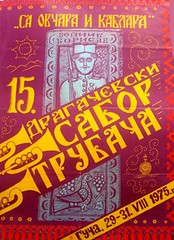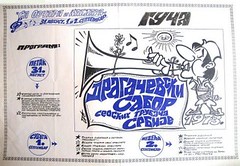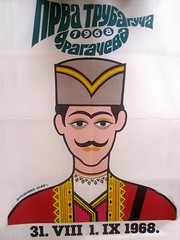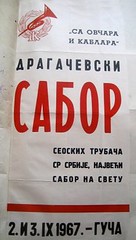.jpg)
Posts mit dem Label gucha gucha werden angezeigt. Alle Posts anzeigen
Posts mit dem Label gucha gucha werden angezeigt. Alle Posts anzeigen
History of Guča Festival
The traditional Dragačevo trumpet - its cult kept alive for nearly two centuries regardless of political and social considerations - has with time become world-renowned. It is owing to the trumpet that the name of Serbia has resounded worldwide, in all the continents. Some orchestras, when they appear on stage, whether for official competition national dress, the authentic and indigenous dances and other folk inspired elements, coupled with music, have become an integral part of national gathering.
The virtuoso music performers, the trumpet players to the paradox and make the story more authentic - are for the most part fully self-taught. They play by ear and quite spontaneously, relying on their musical memory; they play from the heart and soul, and their music reaches out to listeners precisely for this quality. The Gucha Assembly of Trumpet Players continues to grow year after year: today, this musical feast of recognizable national skills is more popular, more diverse and bigger than ever before.
.jpg)
The first Dragacevo Assembly of Trumpet Players was held on October 16, 1961 in the yard of the Church of Sts. Michael and Gabriel in Gucha. Initially, it was a very modest Assembly - almost subversive for the prevailing political circumstances of that time. However, the Assembly gradually grew and expanded its, one might say, magical influence, and over the past ten or so years has become the folk remained its key symbol and raison detre, it is no longer held solely for the trumpet players. It grew into an Assembly of toastmasters, painters, song "Sa Ovcara I Kablara", marks the beginning of the festival each year. Some church music festivals notwithstanding, the Assembly of Trumpet Players is the best know event of this kind extending uninterruptedly for 43 years and attracting guests and musicians alike from every continent. Trumpet players and folk song and dance groups from around the world deem it a great honor to be invited to the Assembly, and the number of v visitors increases with each coming year. The record was set in 2002, when Gucha hosted in excess of 300.000 visitors.
With considerable experience in organizing Assemblies, today the traditionally hospitable Gucha has earned its place on the map of world music festivals, inviting high interest from ethno music lovers, and deservedly so. As an internationally recognized trumpet capital, and a singular corner of positive energy, a place with accumulated joy, gaiety and spontaneity, coupled with the piercing yet gentle sound of the trumpet, Gucha is a place of catharsis of the heart and soul while the festival lasts. All this is more than enough to attract visitors to Gucha each Mexico, Spain, Greece, Denmark, China and many other close or distant countries. The names of Boban Markovic, Milan Mladenovic, Ekrem Sajdic, Elvis Ajdinovic, Fejat and Zoran Sejdic have carried the glory of the Serbian trumpet across the world. Some 600,000 visitors are expected at the next, and 50th Assembly. That would be very impressive indeed, would it not?
History of Guča Festival
The traditional Dragačevo trumpet - its cult kept alive for nearly two centuries regardless of political and social considerations - has with time become world-renowned. It is owing to the trumpet that the name of Serbia has resounded worldwide, in all the continents. Some orchestras, when they appear on stage, whether for official competition national dress, the authentic and indigenous dances and other folk inspired elements, coupled with music, have become an integral part of national gathering.
The virtuoso music performers, the trumpet players to the paradox and make the story more authentic - are for the most part fully self-taught. They play by ear and quite spontaneously, relying on their musical memory; they play from the heart and soul, and their music reaches out to listeners precisely for this quality. The Gucha Assembly of Trumpet Players continues to grow year after year: today, this musical feast of recognizable national skills is more popular, more diverse and bigger than ever before.
.jpg)
The first Dragacevo Assembly of Trumpet Players was held on October 16, 1961 in the yard of the Church of Sts. Michael and Gabriel in Gucha. Initially, it was a very modest Assembly - almost subversive for the prevailing political circumstances of that time. However, the Assembly gradually grew and expanded its, one might say, magical influence, and over the past ten or so years has become the folk remained its key symbol and raison detre, it is no longer held solely for the trumpet players. It grew into an Assembly of toastmasters, painters, song "Sa Ovcara I Kablara", marks the beginning of the festival each year. Some church music festivals notwithstanding, the Assembly of Trumpet Players is the best know event of this kind extending uninterruptedly for 43 years and attracting guests and musicians alike from every continent. Trumpet players and folk song and dance groups from around the world deem it a great honor to be invited to the Assembly, and the number of v visitors increases with each coming year. The record was set in 2002, when Gucha hosted in excess of 300.000 visitors.
With considerable experience in organizing Assemblies, today the traditionally hospitable Gucha has earned its place on the map of world music festivals, inviting high interest from ethno music lovers, and deservedly so. As an internationally recognized trumpet capital, and a singular corner of positive energy, a place with accumulated joy, gaiety and spontaneity, coupled with the piercing yet gentle sound of the trumpet, Gucha is a place of catharsis of the heart and soul while the festival lasts. All this is more than enough to attract visitors to Gucha each Mexico, Spain, Greece, Denmark, China and many other close or distant countries. The names of Boban Markovic, Milan Mladenovic, Ekrem Sajdic, Elvis Ajdinovic, Fejat and Zoran Sejdic have carried the glory of the Serbian trumpet across the world. Some 600,000 visitors are expected at the next, and 50th Assembly. That would be very impressive indeed, would it not?
Day trip to Ovčarsko Kablar canyon
Day trip to Ovcarsko Kablar canyon - Trumpet Festival It is located in central Serbia, where the Morava river between the mountains and Shepherd Kablar gorge cuts an imposing shadow scale in forest on the banks of the river, the small plateau close to the rocks and hiding the 11 medieval monasteries, the unique place where there are time when they occur. On the left side of the Western Morava are the Annunciation, Ilinje, Savinja Nikolje, Assumption and Jovanje, and on the right the Temple, Trinity, Transfiguration, Assumption and the Presentation.
Day trip to Ovčarsko Kablar canyon
Day trip to Ovcarsko Kablar canyon - Trumpet Festival It is located in central Serbia, where the Morava river between the mountains and Shepherd Kablar gorge cuts an imposing shadow scale in forest on the banks of the river, the small plateau close to the rocks and hiding the 11 medieval monasteries, the unique place where there are time when they occur. On the left side of the Western Morava are the Annunciation, Ilinje, Savinja Nikolje, Assumption and Jovanje, and on the right the Temple, Trinity, Transfiguration, Assumption and the Presentation.
Serbian Monasteries Nemanjić and Žiča
Nemanjic's Monasteries - The monastery of Zica, a foundation of King Stefan the First - Crowned from the beginning of 13 century. It used to be the seat of the first Serbian archbishopric and archbishop Sava Nemanjic. Here was crowned Stefan the First - Crowned, the first Serbian ruler "wreathed by the royal crown" in 1217.
Studenica monastery, a foundation of Stefan Nemanja which the creator of the Serbian state and church built at the peak of his power toward the end of 12 century was the seat of creation of first Serbian literary works and early Serbian fresco painting. The Church of the Virgin served also as the mausoleum of the dynasty and its founder.
Visit Serbian Monasteries
Day 1th: Arrival to Belgrade. Meeting of passengers and representatives of the agency at the airport Nikola Tesla - Belgrade. Transfer to the hotel. Spare time. Overnight.
Day 2nd: Breakfast. Route: Belgrade - Vrnjačka Banja [spa]
Sanctum places of Serbian capital [St. Petka Chapel and Church Ružica, Orthodox Church and Patriarch's residence, St. Sava's Temple, the biggest Orthodox Temple in the Balkans]. Departure to Vrnajčka banja. Visit to the Monasteries Pokajnica, Manasija, and Ravanica; lunch in the monastery. Arrival to Vrnajčka banja. Accommodation. Overnight.
Day 3rd: Breakfast. Route: Vrnajčka banja - Monasteries Žiča, Ljubostinja, Kalenić - Vrnjačka Banja. Lunch is planned in Monastery Kalenić. Visit to the open - air Museum "Kalenić" and familiarizing with the old Serbian crafts: weaving, spinning, knitting, basket weaving. Presentation of the national architecture and traditional usable objects.
Return to Vrnjačka Banja. Accommodation. Overnight.
Day 4th: Breakfast. Spare time. Route: Vrnjačka Banja - Monastery Studenica.
Visit to Monasteries Djurdjevi Stupovi, Sopoćani. Arrival to Monastery Studenica. Lunch. Accommodation in the Monastery's residential building and presence to the evening prayer. Overnight
Day 5th: Breakfast in the Monastery residential building. Route: Studenica - Ovčar banja [spa] - Ovčarsko - Kablarska Gorge - Valjevo
Visit to Monastery Gradac [long hiking tour] and St. Peter's Church on the way to Ovčar Banja. Arrival to Ovčar banja. Lunch in the national restaurant. Visit to the Monasteries of Ovčarsko - Kablarska Gorge: Vavedenje [Presentation of the Virgin], Vaznesenje [Resurrection], Sretenje [Meeting of Our Lord in the Temple], Svete Trojice Blagovestenje [Annunciation of Holy Trinity], Ilinje, Savinje, Nikolje, Jovanje i Uspenje [Dormition]. Departure to Valjevo. Accommodation. Overnight.
Day 6th: Breakfast. Route: Valjevo - village Sitarice - Valjevo.
Petnica cave, Research Center in Petnica. Visit to the old city center Tešnjar, Muselin's konak [hist. castle, palace], the monument of the greatest Serbian army commander Živojin Mišić, and the monument of poetess Desanka Maksimović]. Visit of the Monasteries Ćelije and Lelić in which are the relics of the Bishop Nikolaj Velimirović, the Orthodox theologian and writer from 20th century. Visit to the Monastery Pustinja from 14th century, built during the rule of the Nemanjić royal family.
Visit to the village Sitarice on the hillsides of Medvednik Mountain. This is the place with traditional, old Serbian houses, outbuildings, folklore, customs and traditional dishes of Serbian cuisine are preserved and cherished. In the yard of an old authentic village house, Serbian dining table brimming with national dishes and drinks, traditional Serbian host, songs and dancing typical for this part of Serbia, welcomes guests. Return to the hotel. Overnight.
Day 7th Breakfast. Route: Valjevo - Soko Grad - Monastery Tronoša - Tršić - Belgrade
Departure from Valjevo. Arrival to Soko Grad and visit to the Monastery Complex of "Soko Grad". Short break. Departure to Monastery Tronoša and Trsić. Visit to the Monastery Tronoša and monastery residential building. Visit to the Ethnographic Commemorative Park and Commemorative House dedicated to the father of Serbian literacy Vuk Stefanović Karadžić in Tršić. Lunch break and individual activities. Departure to Belgrade in the evening. Accommodation in the hotel. Overnight.
Day 8th: Breakfast. Transfer to the airport; departure.
Gledičke Mountains
Description: In the hearth of Šumadija, on the slopes of the Gledičke Mountains, there is one of the most pleasant parts of Central Serbia, hilly landscape full of clear springs, rivers, gorges, medical herbs, game... It is a grove decorated with picturesque natural attractions, better known as Levac. It can also be recognized by the Kalenić Monastery, spiritual and cultural center, of which protected area we care. Open - air Museum "Kalenić" acquaints visitors with authentic experience and tradition, customs, history and culture of Levac, national kitchen, correlates with domestic and wild animals in nature. Youngest devotees of nature and healthy life can express their creativity and research spirit within the educational workshops in healthy and attractive natural environment:
Leaving Belgrade at 7:00 AM Arrival at Kalenic at 11:00 AM from 11:00h until 17:00h
- familiarizing with the old handycrafts and participating in making toys and souvenirs of natural materials [weaving, spinning, knitting, basket weaving…],
- visit to the Monastery; a lesson about Despot Stefan Lazarević,
- presentation of the folk architecture and traditional usable things [visit to the households],
- participating in the workshop of fine arts [presentation of Janko Baršić naïve art school],
- recreation in nature, learning old children's games, familiarizing with natural lair of animals, plants, bird watching…
- familiarizing with domestic animals and ways of cultivating land, planting and growing, cereals, fruits and vegetables,
- enjoying honey and its products,
- visit to a watermill and manifestation of grinding wheat,
- participating in the production of homemade dishes and products [bred baking, curdling, making jam, drying fruit, making soaps…].
Workshops are adjusted to juvenile; a lot of games, songs and careless socializing in pure nature.
Arrival at Belgrade around 09:00 PM
Spa Banja Koviljaca
Day 1th: Arrival Arrival to Belgrade. Accommodation in three star hotel. Dinner. Overnight.
Day 2nd: Breakfast. Checkout. Route: Belgrade - Banja Koviljača. Belgrade sightseeing with a professional tourist guide [City Parliament, Federal Parliament, Terazije Square, Republic Square, Students' Square, Belgrade Fortress, City Gate ["Varoš kapija"], New Belgrade, Topčider Hill, Dedinje, Oslobodjenje Square, Slavija Square, Nikola Pašić Square. Departure to Koviljača Spa.
Visit to Zasavica Swamp, Natural Reservation as we pass along. In this beautiful natural reservation you can enjoy shipping on the tourist boat [without engine], photo - safari and richness of natural and animal world - 200 species of plants, 120 species of birds, more than 20 species of fish… Lunch in the national restaurant "Čardak". Arrival to the Koviljača Spa in the evening. Accommodation and dinner.
Overnight.
Day 3rd: to 9th Full board [FB] arrangement in Spa. The use of wellness program in health resort or sanitary and therapy services under the professional medical control is planned for the guests.
Every day in the afternoon, an excursion is planned for visiting cultural, historical and natural sights in the area.
Day 10th: Breakfast. Departure to Belgrade.
Spa Banja Koviljaca
Day 1th: Arrival Arrival to Belgrade. Accommodation in three star hotel. Dinner. Overnight.
Day 2nd: Breakfast. Checkout. Route: Belgrade - Banja Koviljača. Belgrade sightseeing with a professional tourist guide [City Parliament, Federal Parliament, Terazije Square, Republic Square, Students' Square, Belgrade Fortress, City Gate ["Varoš kapija"], New Belgrade, Topčider Hill, Dedinje, Oslobodjenje Square, Slavija Square, Nikola Pašić Square. Departure to Koviljača Spa.
Visit to Zasavica Swamp, Natural Reservation as we pass along. In this beautiful natural reservation you can enjoy shipping on the tourist boat [without engine], photo - safari and richness of natural and animal world - 200 species of plants, 120 species of birds, more than 20 species of fish… Lunch in the national restaurant "Čardak". Arrival to the Koviljača Spa in the evening. Accommodation and dinner.
Overnight.
Day 3rd: to 9th Full board [FB] arrangement in Spa. The use of wellness program in health resort or sanitary and therapy services under the professional medical control is planned for the guests.
Every day in the afternoon, an excursion is planned for visiting cultural, historical and natural sights in the area.
Day 10th: Breakfast. Departure to Belgrade.
Abonnieren
Kommentare (Atom)

.gif)
.gif)

